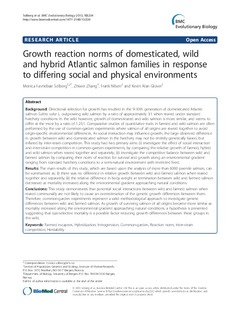| dc.description.abstract | Background: Directional selection for growth has resulted in the 9-10th generation of domesticated Atlantic salmon Salmo salar L. outgrowing wild salmon by a ratio of approximately 3: 1 when reared under standard hatchery conditions. In the wild however, growth of domesticated and wild salmon is more similar, and seems to differ at the most by a ratio of 1.25: 1. Comparative studies of quantitative traits in farmed and wild salmon are often performed by the use of common-garden experiments where salmon of all origins are reared together to avoid origin-specific environmental differences. As social interaction may influence growth, the large observed difference in growth between wild and domesticated salmon in the hatchery may not be entirely genetically based, but inflated by inter-strain competition. This study had two primary aims: (i) investigate the effect of social interaction and inter-strain competition in common-garden experiments, by comparing the relative growth of farmed, hybrid and wild salmon when reared together and separately; (ii) investigate the competitive balance between wild and farmed salmon by comparing their norm of reaction for survival and growth along an environmental gradient ranging from standard hatchery conditions to a semi-natural environment with restricted feed.
Results: The main results of this study, which are based upon the analysis of more than 6000 juvenile salmon, can be summarised as; (i) there was no difference in relative growth between wild and farmed salmon when reared together and separately; (ii) the relative difference in body weight at termination between wild and farmed salmon decreased as mortality increased along the environmental gradient approaching natural conditions.
Conclusions: This study demonstrates that potential social interactions between wild and farmed salmon when reared communally are not likely to cause an overestimation of the genetic growth differences between them. Therefore, common-garden experiments represent a valid methodological approach to investigate genetic differences between wild and farmed salmon. As growth of surviving salmon of all origins became more similar as mortality increased along the environmental gradient approaching natural conditions, a hypothesis is presented suggesting that size-selective mortality is a possible factor reducing growth differences between these groups in the wild. | no_NO |
